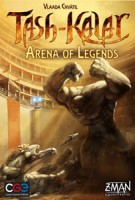
Tash-Kalar: Arena of Legends
Overview
Players take turns placing magical stones into an arena in strategic formations hoping to bring forth the life essence of magical or even legendary Beings. These Beings will flicker into existence for a brief moment and in that moment, exert a special power on the other stones – most likely destroying them. With two modes of play: High Form and Deathmatch Duel, players will seek to gain the most points and emerge victorious.
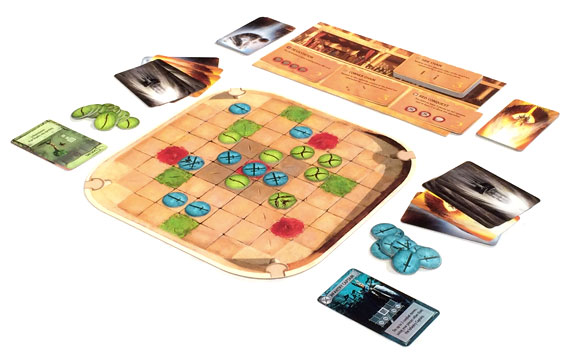
Set Up
Set up the game board and choose a school: a deck of Beings that can be summoned during battle. Take the corresponding tokens matching the color of the school you have chosen. The Flare cards are shuffled as are the Legendary Beings cards, and each forms a face down deck that all players will share. Draw three cards from your own Player deck, two cards from the Legendary Beings deck and one Flare card. This forms your starting hand.
Depending upon the form of game being played, scoring boards will be set up as well. In the High Form, a Task board is assembled and a deck of Task cards is shuffled. Three Tasks are drawn and placed on the Task board. In addition, turn up the top card of the Task draw deck.
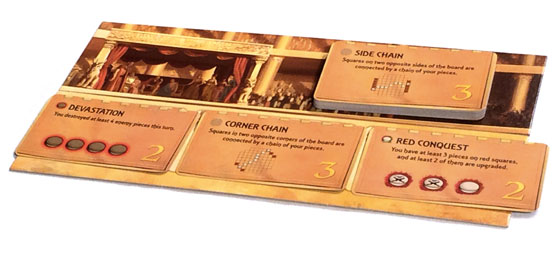
In the Deathmatch Duel form, two Deathmatch Duel scoreboards are assembled to form a scoring track numbered 0-20. The battle is about to begin!
Gameplay (The High Form)
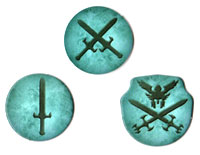
Gameplay for Tash-Kalar is simple. You are a mage summoning Kalarite stones into an arena. These stones are represented by tokens that have three distinct ranks: Common, Heroic and Legendary.
You have two actions per turn: you may place a Common stone onto the arena, and/or summon a Being card from your hand if possible. When placing a Common stone you seek to create a formation that matches the formation listed on any of the Beings in your hand. If successful, you may then use an action to summon the essence of that Being by playing the card and placing a token of its rank into the arena on the space designated by a white outline on the card. Once the Being enters play, its game effect triggers immediately. Then the Being reverts to Kalarite and may be useful in creating more powerful formations in the same or future turns.
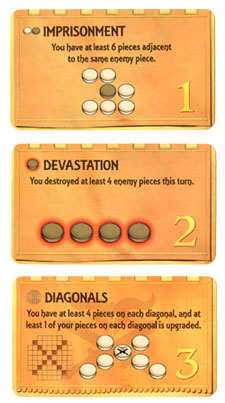
After using your two actions, by placing stones or summoning, you may then check the Task board to see if you have met the criteria of one of the Task cards there. Points are awarded by accomplishing these Tasks which usually involve destroying your opponent’s Kalarite stones or in some cases having your stones in certain formation across the arena.
At the end of your turn, you must replenish your hand so that you have 3 regular Being cards, 2 Legendary Being cards and one Flare card. The turn then passes to your opponent(s).
Play alternates between players until a player scores 7 points first, without anyone running out of cards. This will trigger the end of the High Form game. (The game end triggers when a player has 17 points in the Deathmatch Duel form). The game can also end when a player runs out of cards. The player with the most points is declared the Champion of Tash-Kalar!
Destruction!
As you can see, the game turns are relatively simple. However the diversity of the action relies on the effects of the Being cards and your ability to destroy your opponents’ Kalarite stones – taking away their ability to complete Tasks.
First, when a Being is summoned, it may be summoned onto an empty space, or it may be summoned onto a space of a token of equal or lower rank. So the first level of destruction may happen before a Being’s effect even triggers. You may even choose to destroy your own stone in this way, which may serve to place you in a better tactical position – setting up another summoning.
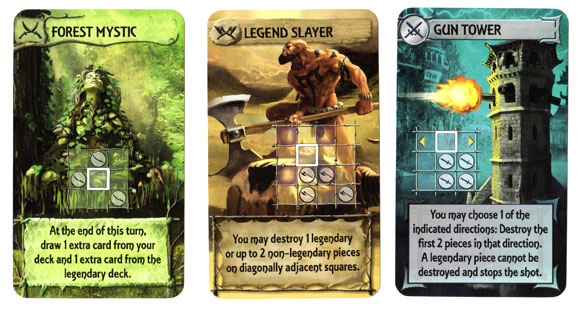
Most of the time, destruction happens when a Being’s effects trigger. When this happens the illustration on the card will dictate what squares will be affected. This recreates the magical effects of the creatures that are summoned. It can be anything from a giant canon blowing every stone in a straight line to kingdom come or a magical blast that affects every piece in a field of squares. Some Beings may move when summoned, such as a Knight charging ahead into a line of enemy stones or a Griffin Rider flying into battle. These moves can be Standard moves, Combat moves and Leaps.
A Standard move allows you to move a Being onto an empty square or a square occupied by a stone of lesser rank. A Combat move allows you to move into a square occupied by a stone of lesser or equal rank. And a Leap is just the same as a Combat move, but you are not limited by only moving to adjacent squares.
Flares
Flare cards are magical effects that you can invoke if things are not going well for you in the arena. Each Flare card has a top and a bottom portion and each has a perquisite for you to be able to use it. The upper effect of the card can be triggered if your opponent’s Upgraded pieces exceed yours by a certain number as depicted on the card. The effect on the lower portion can be triggered if your opponent’s total number of pieces exceeds yours by at least the indicated number. Both may be triggered as well. In this way, invoking Flares keeps the game in balance so no one player runs away with victory.
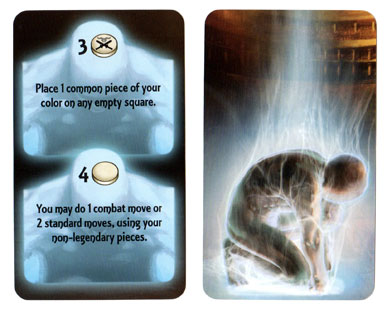
Deathmatch Duel!
The other form of the game is a Deathmatch Duel where tasks are eliminated and players score point based on sheer destruction. Every stone you destroy is placed next to you, and you score points based on its rank: 2 points for a Legendary stone, 1 point for a Heroic stone and half a point for a Common stone. The first Player to 17 points is declared the champion.
Components
The art work by David Cochard is excellent and eye-catching and may even create a slight obstacle (explained below). The cards are of good stock and easily legible. The cardboard tokens and game boards are well made and durable. Also it bears mentioning that Z-man usually includes plastic storage bags for game components. Well done!
Learning Curve
Low. The rulebook eases you into the gameplay with a basic version of the game and ample illustrations – along with a fun thematic narration by a “wizened master” (who looks more like a lowly goblin). But really, the game is very easy to play. The challenge, as is true with most great games, is your ability to master it. For that, many game plays will be required.
Who would enjoy this game?
Final Thoughts
”Fast and vicious! Yes, it’s an arena combat game. Wait…no it’s not. It’s an abstract strategy game. Huh?”
“I just summoned a legendary being! Its power is mine to command! Wait…it just turned to stone and is now a token. Ghah!”
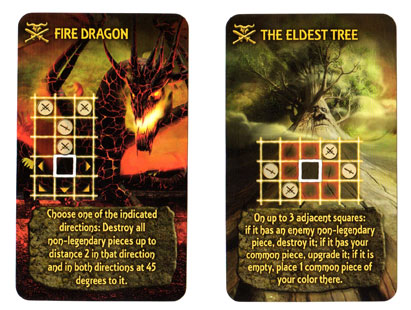
Looking at Tash-Kalar (thanks to the amazing artwork), you may believe you are about to play an arena battle game where creature stats and special abilities go head-to-head with your opponent’s monsters. That some form of simultaneous action selection or variable player powers and combat system will allow tense dice rolls and strategic decisions.
Nope.
What you are getting is a brilliantly designed, thematic, abstract, tactical, arena battle game. (Whew!) When you play your very first game, it will seem limiting, and then surprise you with its depth. It won’t be exactly what you think it’s going to be, and you will realize you are thinking much more than you thought you would. But it still will give you those great moments of victory, as well as the ultimate “DV” moment: (That’s Darth Vader: “Noooooooooooooo!”)
Look at all the “maybes” in the “Who would Like This Game” section. What Mr. Chvátil has done is challenged our perception of what we thought we knew we liked to play. This game is surprising and very challenging and, as was already mentioned, seems very expandable. But is it for you? Um… Yes and No?”
The best we can say is, find a friend or a demo copy and play the game to see if you like it. See if it surprises you, hurts your brain or turns you off. It really will depend on your preferences. But one thing is for certain: for pushing the boundaries and creating a game that you will either love or hate, in our hobby, Vlaada Chvátil is a “Legendary Being.”
Post Script: We really, really wanted to find out how Vlaada came up with this one. It is fun to read all about it at www.tash-kalar.com.
User Reviews (1)
Add a Review for "Tash-Kalar: Arena of Legends"
You must be logged in to add a review.

You’re sitting contemplating your next move when you hear your opponent grunt “shapes”. You know exactly what troubles his weary mind. He decides just to play a couple tokens and you breath a sigh of relief for a stint of the onslaught you’ve endured thus far. You play a token and finally play a card to gain the upper hand! Next turn you are flared then fall behind with end game triggered…
That is just a taste of 2 player deathmatch. I have played a total of 3 games (first being the noob friendly version of high form) and so far there hasn’t been a dull moment. I enjoy both game modes and seriously look forward to melee and teams (I’ve only played with one other person thus far).
I really enjoy the thinking aspect of Tash-Kalar and the theme is a welcomed break from other games that just seem to one up each other. Not much more I can say that wasn’t stated in this review already other than they really thought it out well and you can see and fell the love poured into this game. Great buy if you enjoy thinking games with no solid strategy.